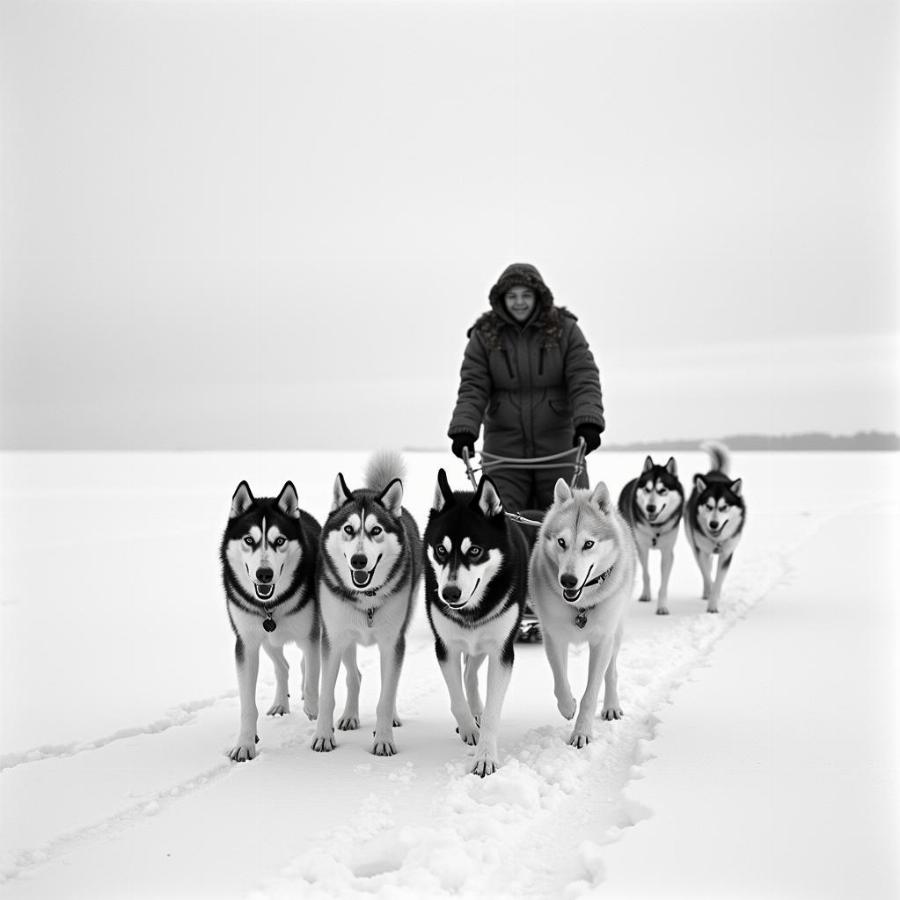The Sakhalin Husky, also known as the Karafuto Ken, is an extremely rare breed of sled dog originating from Sakhalin Island in Russia. Known for their strength, endurance, and calm temperament, these dogs have a rich history intertwined with the indigenous people of Sakhalin. This comprehensive guide will delve into the fascinating world of the Sakhalin Husky, exploring their history, temperament, care requirements, and more.
History of the Sakhalin Husky
The Sakhalin Husky’s history dates back centuries. These dogs were originally bred by the Nivkh people, indigenous inhabitants of Sakhalin Island and parts of eastern Russia. The Nivkh relied heavily on these dogs for transportation, hunting, and companionship in the harsh, snowy environment. Sakhalin Huskies pulled sleds, assisted in hunting seals and bears, and even provided warmth in frigid temperatures.
Expert Insight: “The Sakhalin Husky played an integral role in the survival of the Nivkh people,” explains Dr. Elena Petrova, a leading veterinarian with a specialization in ancient dog breeds. “Their strength and resilience made them invaluable companions in one of the world’s harshest climates.”
 Sakhalin Husky Historical Photo
Sakhalin Husky Historical Photo
A Story of Survival
One of the most poignant stories highlighting the breed’s loyalty and resilience is the ill-fated Japanese expedition to the South Pole in 1958. The expedition team was forced to evacuate, leaving behind 15 sled dogs, including Sakhalin Huskies. Miraculously, one year later, two dogs, Taro and Jiro, were found alive. They had survived the harsh Antarctic winter against all odds. This tale of survival captured the world’s attention, solidifying the Sakhalin Husky’s reputation for strength and endurance.
Sakhalin Husky Characteristics
Sakhalin Huskies are a medium-sized breed, typically weighing between 66 and 88 pounds and standing 22-26 inches tall. Their double coat, which comes in a variety of colors including white, black, red, and grey, provides insulation against extreme cold. They have a powerful build, a wedge-shaped head, and erect, triangular ears.
Temperament and Personality
Known for their gentle and loyal nature, Sakhalin Huskies are intelligent and eager to please. They thrive in cold climates and enjoy activities like sledding, hiking, and even swimming.
Expert Insight: “While they possess a strong work ethic, Sakhalin Huskies are also incredibly affectionate and bond closely with their families,” says renowned dog trainer, Mark Williams. “Early socialization and consistent training are essential to ensure they grow into well-adjusted companions.”
Caring for a Sakhalin Husky
Owning a Sakhalin Husky is a considerable responsibility. Their unique needs require a dedicated owner who can provide ample exercise, mental stimulation, and proper care.
Exercise and Mental Stimulation
Sakhalin Huskies are high-energy dogs with a strong work drive. They require a minimum of two hours of exercise daily and thrive in active households. Activities such as sledding, bikejoring, and even agility training can help channel their energy and keep them mentally stimulated.
Grooming
Due to their thick double coat, Sakhalin Huskies require regular brushing, especially during shedding season. Weekly brushing helps remove loose hair and prevent mats.
Health
Sakhalin Huskies are generally healthy dogs with a lifespan of 10-15 years. However, like all breeds, they are prone to certain health conditions. Regular veterinary check-ups, vaccinations, and a balanced diet are crucial for maintaining their overall health.
Finding a Sakhalin Husky
Due to their rarity, finding a Sakhalin Husky can be extremely challenging. Reputable breeders are scarce, and potential owners should be prepared to join a waiting list and undergo a thorough screening process. Adopting a Sakhalin Husky is even more unlikely given their limited numbers.
FAQ:
Q: Are Sakhalin Huskies good family dogs?
A: Yes, Sakhalin Huskies are known for their gentle and loyal nature, making them suitable for families with children and other pets, provided they receive proper socialization and training.
Q: Do Sakhalin Huskies bark a lot?
A: While not excessive barkers, Sakhalin Huskies are prone to howling, especially when bored or left alone for extended periods.
Q: Can Sakhalin Huskies live in warm climates?
A: Sakhalin Huskies are best suited for cold climates. They can adapt to warmer temperatures to some extent but require access to shade, water, and air conditioning during hot weather.
Looking for More Information?
Interested in learning more about other rare dog breeds or finding resources for responsible dog ownership? Visit Beaut Dogs at https://beautdogs.com. We offer a wealth of information for dog lovers of all levels.
When you need expert advice and tailored guidance on all things dog-related, reach out to Beaut Dogs at [email protected] for detailed and accurate information.